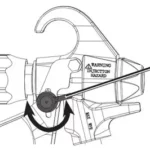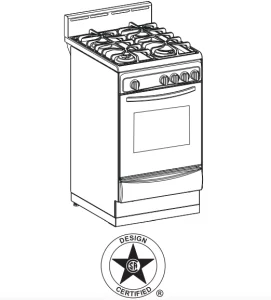
Avanti Elite Gas Range
INSTRUCTION MANUAL
Model Number: DG 202 BS
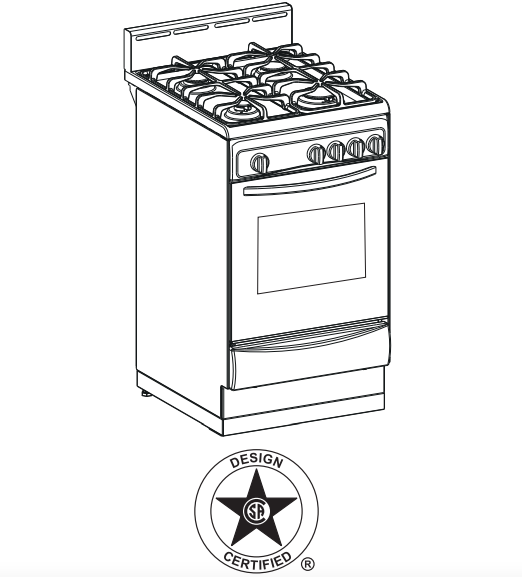
CAUTION:
BEFORE USE, PLEASE READ AND FOLLOW ALL SAFETY RULES AND OPERATING INSTRUCTIONS.
Avanti has a policy of continuous improvement on its products and reserves the right to change materials and specifications without notice.
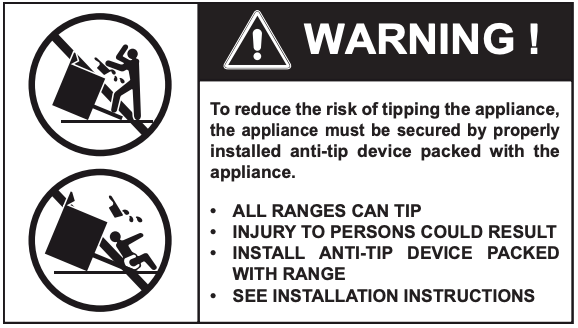

- Do not store or use gasoline or other flammable vapors and liquids in the vicinity of this or any other appliance.
- NEVER use this appliance as a space heater to heat or warm the room. Doing so may result in carbon monoxide poisoning and overheating of the appliance.
- WHAT TO DO IF YOU SMELL GAS:
- Do not try to light any appliance.
- Do not touch any electrical switch.
- Do not use any phone in your building.
- Immediately call your gas supplier from a neighbor’s phone. Follow the gas supplier’s instructions.
- If you cannot reach your gas supplier, call the fire department.
- Installation and service must be performed by a qualified installer, service agency, or the gas supplier.
PARTS and FEATURES


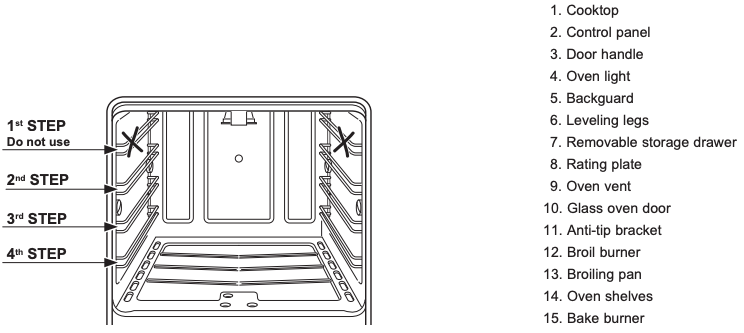
COOKING HOB
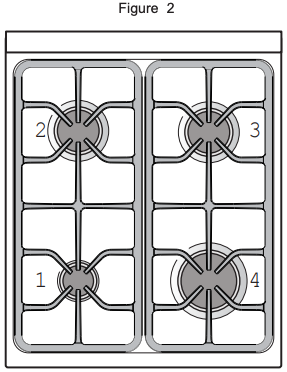
- Auxiliary burner (AUX) – 3500 BTU/hr
- Left semi-rapid burner (SR) – 6000 BTU/hr
- Right semi-rapid burner (SR) – 6000 BTU/hr
- Rapid burner (R) – 10000 BTU/hr
Note:
- The electric gas-lighting device is incorporated into the knobs.
CAUTION:
If the burner is accidentally extinguished, turn the gas off at the control knob and wait at least 1 minute before attempting to relight.
CAUTION:
Gas appliances produce heat and humidity in the environment in which they are installed.
Ensure that the cooking area is well ventilated following national/local codes.
CONTROL PANEL
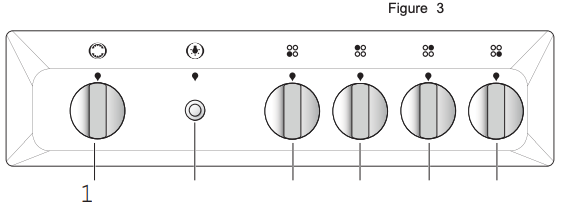
CONTROLS DESCRIPTION
Cooking hob controls:
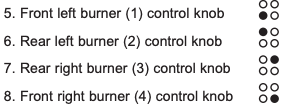
Oven controls:
9. Oven light push button
10. Gas oven/gas broil burner control knob
BEFORE USING YOUR GAS RANGE

Before Using Your Gas Range
- Remove the exterior and interior packing.
- Remove the protective film on steel and aluminium parts
- Check to be sure you have all of the parts listed below:
- Orifice Packet
- Anti-tip Bracket
- 4 leveling legs
- 2 cooking grids
- 4 caps and 4 bases in the burner assembly
- 5 burner knobs
- 1 push button
- Broiler Tray
- Clean the interior surface with lukewarm water using a soft cloth.
- Have the installer show you the location of the ranges gas shut-off valve and how to shut it off if necessary.
- Have your range installed and properly grounded by a qualified installer in accordance with the Installation Instructions.
- Do not attempt to repair or replace any part of your range unless it is specifically recommended in this manual.
- Be sure your range is correctly adjusted by a qualified service technician or installer for the type of gas (natural or LP) that is being used.
- Do not remove permanently affixed labels, warnings, or plates from the product. This may void the warranty.
- The installer should leave these instructions with the consumer who should retain for local inspector’s use and for future reference.
- Please observe all local and national codes and ordinances.
Important:
This appliance is designed and manufactured solely for the cooking of domestic (household) food and is not suitable for any non domestic application and therefore should not be used in a commercial environment.
The appliance guarantee will be void if the appliance is used within a non domestic environment i.e. a semi commercial, commercial or communal environment.
Read the instructions carefully before installing and using the appliance.
CAUTION: this appliance must only be installed in a permanently ventilated room in compliance with the applicable regulations.
It is advised to follow these instructions:
- Clean the interior of the oven with cloth soaked in water and detergent (neutral, then dry carefully.
- Furnish the interior of the oven by assembling the wire racks and by insert shelves and tray (see chapter OVEN ACCESSORIES INSTALLATION AND REMOVAL on page 16).
- Turn the oven on to the maximum temperature to eliminate possible traces of grease from the oven burner. The same operation should be followed for broil burner.
PRECAUTIONS and RECOMMENDATIONS
IMPORTANT PRECAUTIONS AND RECOMMENDATIONS
After having unpacked the appliance, check to ensure that it is not damaged and that the oven door closes correctly. In case of doubt, do not use it and consult your supplier or a professionally qualified technician.
Packing elements (i.e. plastic bags, polystyrene foam, nails, packing straps, etc.) should not be left around within easy reach of children, as these may cause serious injuries.
The packaging material is recyclable and is marked with the recycling symbol 
- Do not attempt to modify the technical characteristics of the appliance as this may cause danger to users.
- Do not carry out cleaning or maintenance operations on the appliance without having previously disconnected it from the electric power supply.
- If you should decide not to use this appliance any longer (or decide to substitute an older model), before disposing of it, it is recommended that it be made inoperative in an appropriate manner in accordance to health and environmental protection regulations, ensuring in particular that all potentially hazardous parts be made harmless, especially in relation to children who could play with unused appliances. Remove the door before disposal to prevent entrapment.
- After use, ensure that the knobs are in OFF position.
- Do not allow children or other unqualified people to use the appliance without your supervision.
- Do not allow children or other unqualified people to use the appliance without your supervision.
- During and after use of the range, certain parts will become very hot. Do not touch hot parts.
- Keep children away from the range when it is in use.
- Some appliances are supplied with a protective film on steel and aluminium parts. This film must be removed before using the appliance.
- Fire risk! Do not store flammable material in the oven or in the bottom drawer.
- Make sure that electrical cables connecting other appliances in the proximity of the range cannot come into contact with the hob or become entrapped in the oven door.
- Do not line the oven walls top and bottom with aluminium foil. Do not place shelves, pans, backing trays broil tray or other cooking utensils on the base of the oven chamber.
- The manufacturer declines all liability for injury to persons or damage to property caused by incorrect or improper use of the appliance.
- To avoid any possible hazard, the appliance must be installed by qualified personnel only. Any repairs by unqualified persons may result in electric shock or short circuit. In order to avoid possible injuries to your body or to the appliance, do not attempt any repairs by yourself. Such work should be carried out by qualified service personnel only.
- Danger of burns! The oven and cooking accessories may become very hot during operation. Make sure children are kept out of reach and warn them accordingly. To avoid burns use kitchen clothes and gloves when handling hot parts or utensils.
- Stand away from the range when opening oven door. Hot air or steam which escapes can cause burns to hands, face, and/or eyes.
- Never clean the oven with a high-pressure steam cleaning device, as it may provoke a short circuit.
- This appliance is intended for use in your household. Never use the appliance for any other purpose!
GENERAL INFORMATION

- This appliance shall not be used for space heating. This information is based on safety considerations.
- AlI openings in the wall behind the appliance and in the floor under the appliance shall be sealed.
- Keep appliance area clear and free from combustible materials, gasoline, and other flammable vapors.
- Do not obstruct the flow of combustion and ventilation air.
- Disconnect the electrical supply to the appliance before servicing.
- When removing appliance for cleaning and/or service;
A. Shut off gas at main supply.
B. Disconnect AC power supply.
C. Disconnect gas line to the inlet pipe.
D. Carefully remove the range by pulling outward.
CAUTION: Range is heavy; use care in handling. - The misuse of oven door (e.g. stepping, sitting, or leaning on them) can result in potential hazards and/or injuries.
- When installing or removing the range for service, a rolling lift jack should be used. Do not push against any of the edges of the range in an attempt to slide it into or out of the installation. Pushing or pulling a range (rather than using a lift jack) also increases the possibility of bending the leg spindles or the internal coupling connectors.

ELECTRICAL GROUNDING INSTRUCTIONS
FOR PERSONAL SAFETY, THIS APPLIANCE MUST BE PROPERLY GROUNDED.
This appliance is equipped with a three-prong grounding plug for your protection against shock hazard and should be plugged directly into a properly grounded socket. Do not cut or remove the grounding prong from the plug.
Do not under any circumstances cut or remove the third (ground) prong from the power plug.
Electrical installation should comply with national and local codes.
REPLACEMENT PARTS
Only authorized replacement parts may be used in performing service on the range. Replacement parts are available from factory authorized parts distributors. Contact the nearest AVANTI parts distributor in your area.
HOW TO USE THE TOP BURNERS
GAS BURNERS
Gas flow to the burners is adjusted by turning the knobs which control the valves. Turning the knob so that the indicator line points to the symbols printed on the panel achieves the following functions:

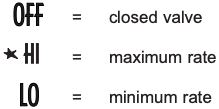
The maximum aperture position permits rapid boiling of liquids, whereas the minimum aperture position allows simmer warming of food or maintaining boiling conditions of liquids.
To reduce the gas flow to minimum, rotate the knob further anti-clockwise to point the indicator towards the LO position.
Other intermediate operating adjustments can be achieved by positioning the indicator between the maximum and minimum aperture positions, and never between the maximum aperture and OFF positions.
N.B. When the range is not being used, set the gas knobs to their OFF positions and also close the gas shut-off valve placed on the main gas supply line.
LIGHTING GAS BURNERS
In order to light the burner, you must:

- Turn the knob in an anti-clockwise direction up to the

The sparks produced by the lighter situated inside the relative burner will light the flame.
In the event that the local gas supply conditions makes it difficult to light the burner in
If there is no mains electrical supply, bring a lighted match close to the burner. - Adjust the gas valve to the desired position.
To re-light the burner, return the knob to the OFF position and repeat the operations for lighting.
Caution!
The range becomes very hot during operation.
Keep children well out of reach.
CHOICE OF BURNER (fig. 6)

The symbols printed on the panel above the gas knobs indicate the correspondence between the knob and the burner.
The most suitable burner is to be chosen according to the diameter and volume capacity of the container to be warmed.
It is important that the diameter of the pots or pans suitably match the heating potential of the burners in order not to jeopardise the efficiency of the burners, bringing about a waste of gas fuel.
A small diameter pot or pan placed on a large burner does not necessarily mean that boiling conditions are reached quicker.

Figure 7

HOW TO USE THE GAS OVEN
GENERAL FEATURES
The gas oven is provided with two burners:
a) Oven burner, mounted on the lower part of the oven (12000 BTU/hr)
b) Broil burner, mounted on the upper part of the oven (8500 BTU/hr).
Attention: the range becomes very hot during operation.
Attention: the oven door becomes very hot during operation.
Keep children away.
WARNING:
The door is hot, use the handle.
USING THE OVEN FOR THE FIRST TIME
It is advised to follow these instructions:
- Furnish the interior of the oven by assembling the wire racks as described at chapter “CARE & MAINTENANCE”.
- Insert shelves and tray.
- Turn the oven on to the maximum temperature (position 550) to eliminate possible traces of grease from the oven burner. The same operation should be followed for broil burner (knob on position BROIL.
- Switch off the electrical supply, let the oven cool down, then clean the interior of the oven with cloth soaked in water and detergent (neutral) then dry carefully.
Figure 8
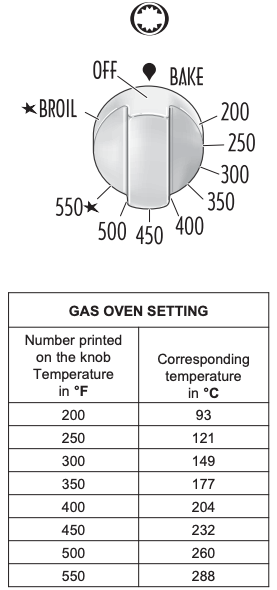
OVEN BURNER
It carries out normal “oven cooking”.
The gas flow to the burner is regulated by a thermostat which allow to maintain the oven temperature constant.
The control of the temperature is assured by a thermostatic probe positioned inside the oven.
The probe must be always kept in its housing, in a clean condition, as an incorrect position or encrustment may cause an alteration in the control of the temperature.
OVEN THERMOSTAT
The numbers printed on the control panel (fig. 8) indicate the increasing oven temperature value (°F). To regulate the temperature, set the chosen number onto the control knob indicator.
The position BROIL serves only to turn on the broil burner.
N.B. When the range is not being used, set the gas knobs to their OFF positions and also close the gas shut-off valve placed on the main gas supply line.
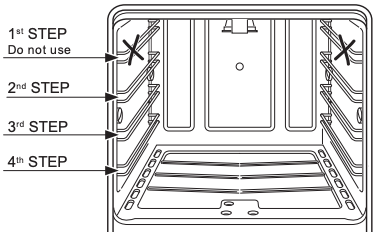
IGNITION OF THE OVEN BURNER
The thermostat allows the automatic control of the temperature. The gas delivery to the oven burner is controlled by a two way thermostatic tap (oven and broil burners) with flame-failure device.
Figure 9
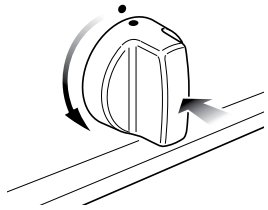
To light the oven burner operate as follows:
- Open the oven door to its full extent.
WARNING: Risk of explosion! The oven door must be open during this operation. - Press the knob right down and turn anti-clockwise (fig. 9) to max position 550.
- Check the oven burner is lit; if not repeat the procedure from step 2.
- Close the oven door slowly and adjust the burner according to the power required.
If the flame extinguishes for any reason, the safety valve will automatically shut off the gas supply to the burner.
To re-light the burner, first turn the oven control knob to position OFF, wait for at least 1 minute and then repeat the lighting procedure.
THE BURNER IGNITION PROCEDURE ALWAYS STARTS WITH THE CONTROL KNOB IN OFF POSITION, OTHERWISE IT IS NOT POSSIBLE TO IGNITE THE BURNER.
Attention: the oven door becomes very hot during operation.
Keep children away.
OVEN COOKING
Before introducing the food, preheat the oven to the desired temperature.
For a correct preheating operation, it is advisable to remove the tray from the oven and introduce it together with the food, when the oven has reached the desired temperature.
Check the cooking time and turn off the oven 5 minutes before the theoretical time to recuperate the stored heat.
IGNITION OF THE BROIL BURNER
The broil burner generates the infra-red rays for broiling.
Figure 10

To light the broil burner operate as follow:
- Open the oven door to the full extent.
WARNING: Risk of explosion! The oven door must be open during this operation. - Press the knob right down and turn clockwise (fig. 10) to the BROIL position.
- Check the broil burner is lit; if not repeat the procedure from step 2.
- Close the oven door slowly
If the flame extinguishes for any reason, the safety valve will automatically shut off the gas supply to the burner.
To re-light the burner, first turn the oven control knob to position OFF, wait for at least 1 minute and then repeat the lighting procedure.
THE BURNER IGNITION PROCEDURE ALWAYS STARTS WITH THE CONTROL KNOB IN OFF POSITION, OTHERWISE IT IS NOT POSSIBLE TO IGNITE THE BURNER.
Do always broil with oven door closed.
Attention: the oven door becomes very hot during operation.
Keep children away.
OVEN LIGHT
Figure 11
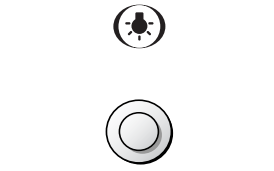
The range is equipped with a light that illuminates the oven to enable visually controlling the food that is cooking
This light is controlled by a push button on the control panel (Fig. 11).
Figure 12
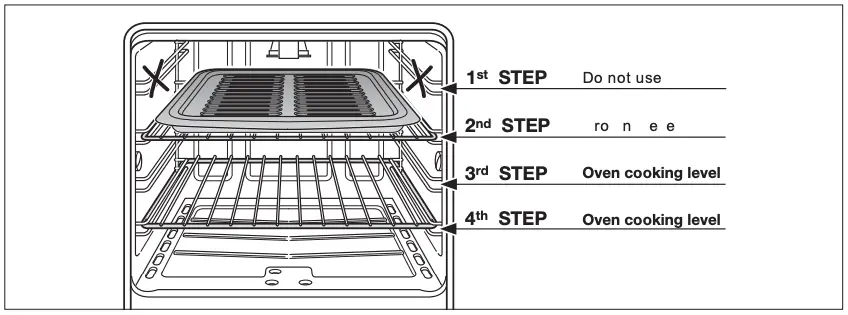
Figure 13

BROILING
Very important: the broil burner must always be used with the oven door closed.
- Position the shelf on the second level from the top (fig. 12).
- Turn on the broil burner, as explained in the preceding paragraphs and let the broil burner preheat for about 5 minutes with the door closed.
- Place the food to be cooked above the broiling pan.
- Introduce the broiling pan in the oven (fig. 13). The broiling pan should be placed above the shelf and it should be centered with the broil burner (fig. 12).
Do not broil without using the broiling pan.
Important: Use always suitable protective gloves when inserting/removing the broiling pan, shelves, pans on other cooking utensils from the oven.
Figure 14

Figure 15

CARE and MAINTENANCE
GENERAL RECOMANDATION
- Important: Before any operation of cleaning and maintenance disconnect the appliance from the electrical supply.
- It is advisable to clean when the appliance is cold and especially for cleaning the enamelled parts.
- Avoid leaving alkaline or acidic substances (lemon juice, vinegar, etc.) on the surfaces.
- Avoid using cleaning products with a chlorine or acidic base.
The oven must always be cleaned after every use, using suitable products and keeping in mind that its operation for 30 minutes on the highest temperature eliminates most grime reducing it to ashes.
WARNING
When correctly installed, your product meets all safety requirements laid down for this type of product category. However special care should be taken around the rear or the underneath of the appliance as these areas are not designed or intended to be touched and may contain sharp or rough edges, that may cause injury.
Figure 16

Figure 17

ENAMELLED PARTS
- All the enamelled parts must be cleaned with a sponge and soapy water only or other non-abrasive products.
- Dry preferably with a soft cloth.
If acid substances such as lemon juice, tomato conserve, vinegar etc. are left on the enamel for a long time they will etch it, making it opaque.
STAINLESS STEEL ELEMENTS
- Stainless steel parts must be rinsed with water and dried with a soft and clean cloth or with a chamois leather.
- For difficult dirt, use a specific non-abrasive product available commercially or a little hot vinegar.
- Note: regular use could cause discolouring around the burners, because of the high flame temperature.
INSIDE OF OVEN
This must be cleaned regularly.
With the oven warm, wipe the inside walls with a cloth soaked in very hot soapy water or another suitable product.
GAS VALVES
In the event of operating faults in the gas valves, call the Service Department.
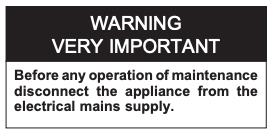
REPLACING THE OVEN LIGHT
Before any maintenance is started involving electrical parts of the appliance, it must be disconnected from the power supply.
- Let the oven cavity and the broil burner cool down;
- Switch off the electrical supply;
- Remove the protective cover;
- Unscrew and replace the bulb with a new one suitable for high temperatures (300°C570°F) having the following specifications: 120V 60 Hz, E14
- Refit the protective cover.
NOTE: Oven bulb replacement is not covered by your guarantee
Do not use steam jet cleaners because the humidity could infiltrate into the appliance making it dangerous.
Figure 18

Figure 19

BURNERS AND GRIDS
- These parts can be removed and cleaned with appropriate products.
- After cleaning, the burners and their flame distributors must be well dried and correctly replaced.
- It is very important to check that the burner flame distributor and the cap has been correctly positioned – failure to do so can cause serious problems.
- In appliances with electric ignition keep the electrode clean so that the sparks always strike.
- Note: To avoid damage to the electric ignition do not use it when the burners are not in place.
CORRECT REPLACEMENT OF THE BURNERS
It is very important to check that the burner flame spreader “F” and the cap “C” have been correctly positioned (see figs. 18 and 19).
Failure to do so can cause serious problems.
In appliances with electric ignition, check that the electrode “S” (fig. 18) is always clean to ensure trouble-free sparking.
The ignition plug must be very carefully cleaned.
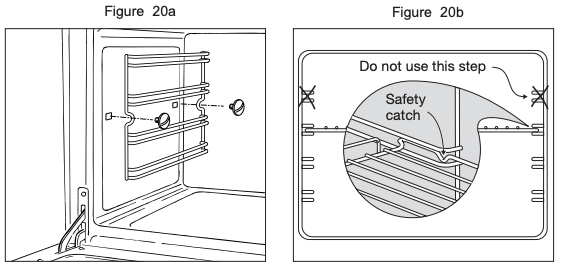
OVEN ACCESSORIES INSTALLATION AND REMOVAL
- Assemble the wire racks on the oven walls using the 2 screws (fig. 20a).
- Slide in, on the guides, the shelves (fig. 20b). Do not use the first step from the top. The rack must be fitted so that the safety catch, which stops it sliding out, faces the inside of the oven.
- Position the broiling pan above the oven shelf (see page 14).
- To dismantle, operate in reverse order.
OVEN DOOR
The internal glass of the oven door can be easily removed for cleaning by unscrewing the two lateral fixing screws (fig. 21).
Figure 21

REMOVABLE STORAGE DRAWER
The drawer (fig. 22) comes out like a normal drawer.
To remove the drawer open and lift it.
Do not store flammable material in the oven or in the bottom drawer.
Figure 22
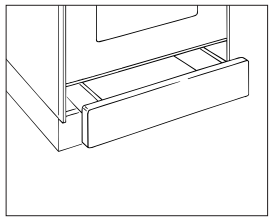
REMOVING THE OVEN DOOR
Type A
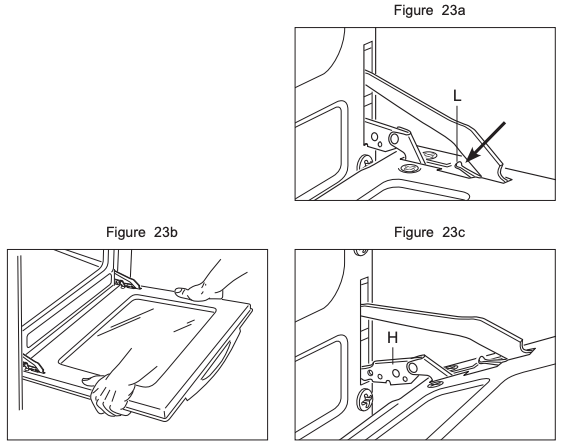
To facilitate oven cleaning, it is possible to remove the door. Please follow the instructions carefully:
- Open the door completely.
- Push down the lever “L” and, keeping it in this position, slowly close the door in order to block the hinge (fig. 23a).
- Grip the door (as indicated in fig. 23b) and, while closing it, release the two hinges as shown in fig. 23c.
- Rest the door on a soft surface.
DOOR ASSEMBLY
- Grip the door with your hands placed near the hinges and raise the levers “H” with your forefingers (fig. 23c)
- Insert the hinges in their position until levers “H” are hooked.
- Open the door completely to obtain the release of levers “L”.
REMOVING THE OVEN DOOR
Type B
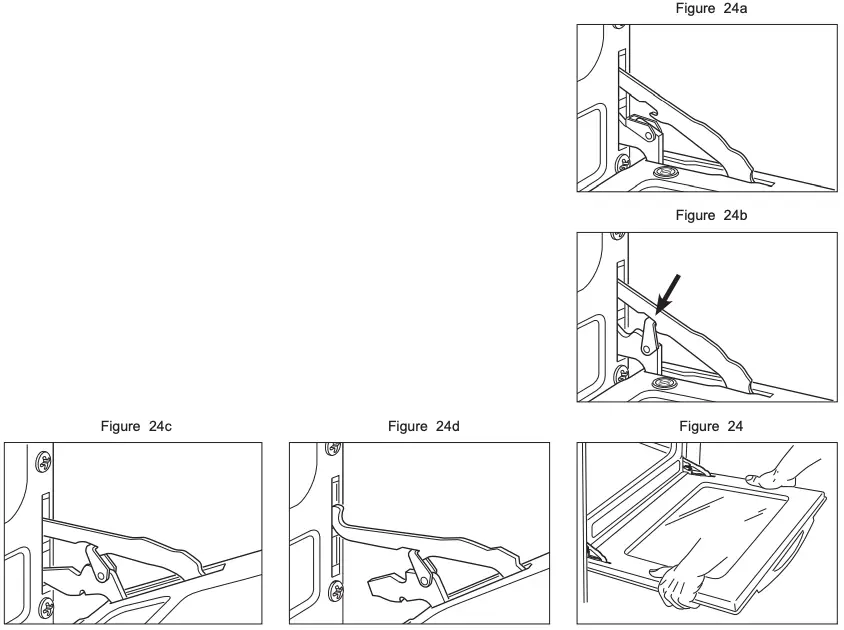
The oven door can easily be removed as follows:
- Open the door to the full extent (fig. 24a).
- Attach the retaining rings to the hooks on the left and right hinges (fig. 24b).
- Hold the door as shown in fig. 24.
- Gently close the door and withdraw the lower hinge pins from their location (fig. 24c).
- Withdraw the upper hinge pins from their location (fig. 24d).
- Rest the door on a soft surface.
- To replace the door, repeat the above steps in reverse order.
TROUBLE SHOOTING GUIDE
PROBLEMS WITH YOUR APPLIANCE?
You can solve many common appliance problems easily, saving you the cost of a possible service call.
Try the suggestions below to see if you can solve the problem before calling the servicer.
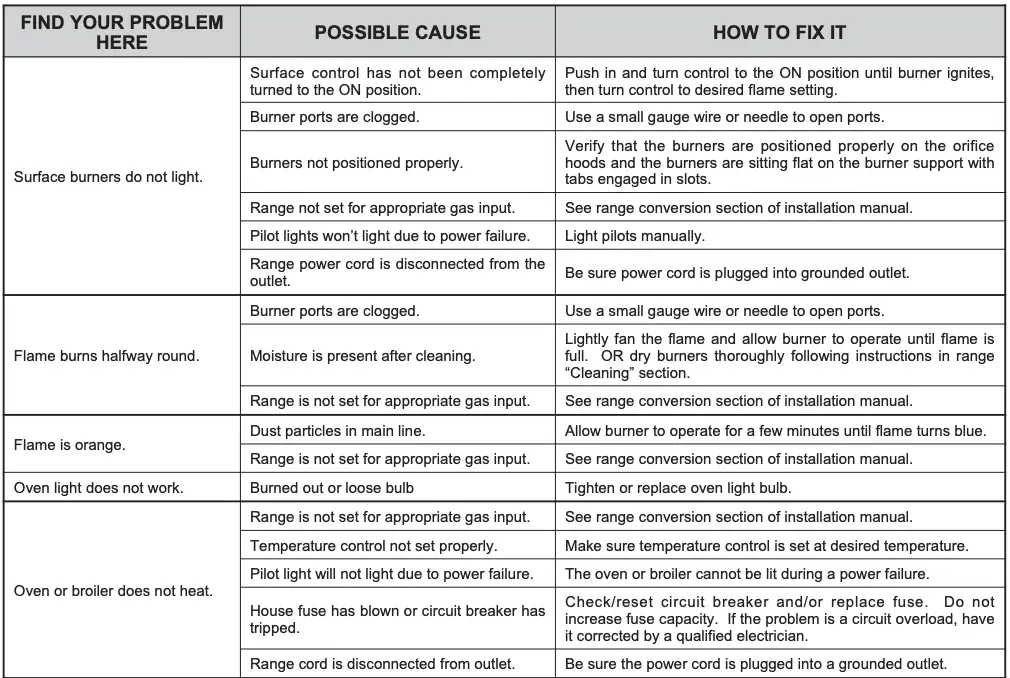
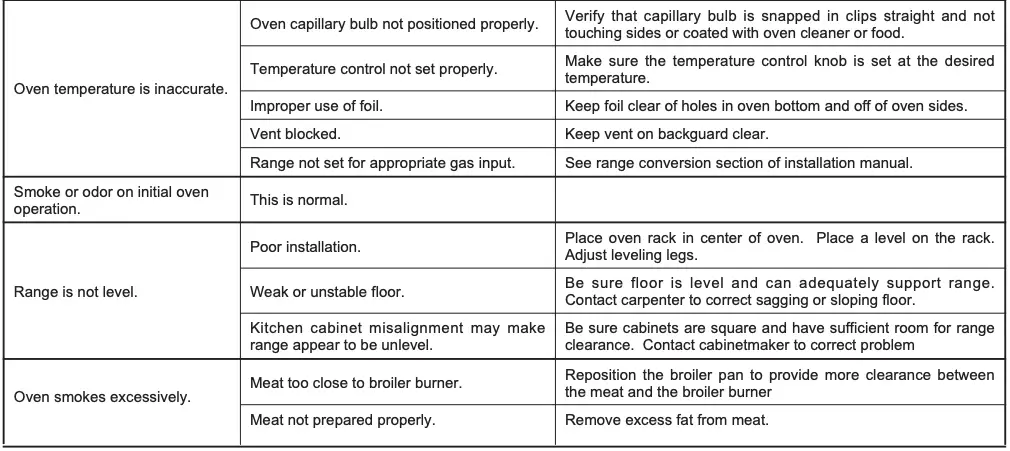
SERVICE
SERVICE FOR YOUR GAS RANGE
We are proud of our customer service organization and the network of professional service technicians that provide service on your Avanti appliances. With the purchase of your Avanti appliance, you can have the confidence that if you ever need additional information or assistance, the Avanti Products Customer Service team will be here for you. Just call us toll-free.
AVANTI PRODUCTS CUSTOMER SERVICES

